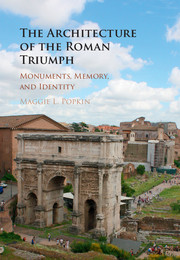Book contents
- Frontmatter
- Dedication
- Contents
- List of Figures
- List of Tables and Color Plates
- Acknowledgments
- INTRODUCTION: THE TRIUMPH, MEMORY, AND “BEING ROMAN” IN THE CITY OF ROME
- 1 THE TRIUMPHAL ROUTE
- 2 BUILDING MEMORIES: THE ERA OF THE PUNIC WARS (264–146 B.C.)
- 3 SPECTACLE AND MEMORY: THE REIGN OF TRAJAN, OPTIMUS PRINCEPS (A.D. 98–117)
- 4 MONUMENTS AND MEMORY DISTORTION: THE REIGN OF SEPTIMIUS SEVERUS (A.D. 193–211)
- CONCLUSION
- Appendix Victory Monuments Built along the Triumphal Route during the Punic Wars: Topography, Dating, and History
- Notes
- References
- Index
- COLOR PLATES
3 - SPECTACLE AND MEMORY: THE REIGN OF TRAJAN, OPTIMUS PRINCEPS (A.D. 98–117)
Published online by Cambridge University Press: 05 July 2016
- Frontmatter
- Dedication
- Contents
- List of Figures
- List of Tables and Color Plates
- Acknowledgments
- INTRODUCTION: THE TRIUMPH, MEMORY, AND “BEING ROMAN” IN THE CITY OF ROME
- 1 THE TRIUMPHAL ROUTE
- 2 BUILDING MEMORIES: THE ERA OF THE PUNIC WARS (264–146 B.C.)
- 3 SPECTACLE AND MEMORY: THE REIGN OF TRAJAN, OPTIMUS PRINCEPS (A.D. 98–117)
- 4 MONUMENTS AND MEMORY DISTORTION: THE REIGN OF SEPTIMIUS SEVERUS (A.D. 193–211)
- CONCLUSION
- Appendix Victory Monuments Built along the Triumphal Route during the Punic Wars: Topography, Dating, and History
- Notes
- References
- Index
- COLOR PLATES
Summary
INTRODUCTION
Rome reached its apogee of wealth, stability, and geographic expanse under the emperor Trajan. Although Trajan led spectacularly successful military campaigns in Dacia, which flooded Rome's coffers with gold, and celebrated two magnificent Dacian triumphs, he is seldom considered in conjunction with the triumphal route. Yet Trajan oversaw the monumentalization of the viewing spot par excellence for triumphs: the Circus Maximus, which could accommodate more spectators for triumphal processions than all Rome's other spectator buildings combined. Trajan enlarged the Circus Maximus and transformed it from a mostly wooden structure to a colossal, marble arena that could house nearly a quarter of Rome's entire population. His Circus Maximus not only provided an enormous venue for viewing triumphs but also eternalized that venue in permanent, lavish materials that evoked Rome's glory even when triumphs and other spectacles were not occurring inside it.
This chapter argues that Trajan's Circus Maximus was designed to generate intense sensations of collectivity amongst Romans viewing his Dacian triumphs and thus to make triumphs more memorable. It exemplifies a trend toward constructing permanent spectator buildings along the triumphal route, including the Theater of Marcellus and, perhaps, the Colosseum, as a means to intensify the experience and memorableness of triumphs under the empire, when they became much more rare as the ritual was restricted to the imperial family. The culmination of this trend is Trajan's Circus Maximus, a fitting home for the urban population of Rome that encouraged Romans to see their city as the center of the world.
The chapter begins by tracing the transformations the triumph underwent in the imperial period. The restriction of the triumph to the imperial family made the ritual occur much more rarely, which increased emperors’ desire for triumphs to pass through permanent spectator buildings that could make them more memorable. It also outlines imperial building projects along the triumphal route prior to Trajan to contextualize Trajan's significant but often underappreciated contributions to the route. It then describes Trajan's building projects along the route, focusing particularly on his spectacular Circus Maximus, before turning to the effects of this colossal structure on how Romans experienced and remembered triumphs under the empire.
- Type
- Chapter
- Information
- The Architecture of the Roman TriumphMonuments, Memory, and Identity, pp. 92 - 134Publisher: Cambridge University PressPrint publication year: 2016



